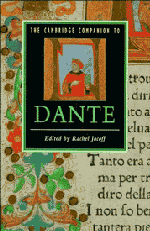Book contents
- Frontmatter
- 1 Life of Dante
- 2 Dante and the lyric past
- 3 Approaching the Vita nuova
- 4 The unfinished author
- 5 Dante and the empire
- 6 Dante and Florence
- 7 Dante and the classical poets
- 8 Dante and the Bible
- 9 The theology of Dante
- 10 A poetics of chaos and harmony
- 11 Introduction to Inferno
- 12 Introduction to Purgatorio
- 13 "Shadowy prefaces"
- 14 Dante and his commentators
- 15 Dante in English
- Further reading
- Index
9 - The theology of Dante
Published online by Cambridge University Press: 28 May 2006
- Frontmatter
- 1 Life of Dante
- 2 Dante and the lyric past
- 3 Approaching the Vita nuova
- 4 The unfinished author
- 5 Dante and the empire
- 6 Dante and Florence
- 7 Dante and the classical poets
- 8 Dante and the Bible
- 9 The theology of Dante
- 10 A poetics of chaos and harmony
- 11 Introduction to Inferno
- 12 Introduction to Purgatorio
- 13 "Shadowy prefaces"
- 14 Dante and his commentators
- 15 Dante in English
- Further reading
- Index
Summary
IT IS COMMONLY said that the Divina Commedia ends with Dante's vision of the Trinity. This will pass as a generalization, but it is not precisely true; and it is not merely a scholarly quibble to note why. When, as his journey is coming to an end, Dante sees the Trinity in the form of three differently colored circles, he notices that an image of man is depicted on the second circle, and his attention is drawn entirely to that fact; at the last he strains to understand how the circle and the image can be united, how God and man can form a unity. It is when this desire is fulfilled, through the granting of a momentary flash of intuition, that the vision comes to an end and Dante acknowledges finally the inability of his imagination to mediate what he understood.
It is entirely apt that the final vision should end in this way, for it may be said that the central quest of Dante's understanding in the poem, and indeed in his œuvre as a whole, was to grasp how the divine is present in the human. Behind the thirst for that knowledge lay the conviction, permeating all his works, that God is supremely to be discovered in human nature.
- Type
- Chapter
- Information
- The Cambridge Companion to Dante , pp. 136 - 152Publisher: Cambridge University PressPrint publication year: 1993
- 2
- Cited by



